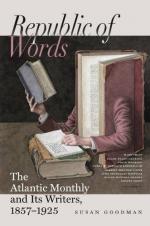might have been known to them,—and if they
were, no doubt Cymburga, like American ladies of to-day,
had the sense and taste to use them. She had
such strength of fist that, when she had occasion
to drive a nail into anything, she dispensed with a
hammer; and she economized in nut-crackers, as some
independent people do in the item of pocket-handkerchiefs,
by using her fingers. One would think that Ernest
would have hesitated to woo and wed a lady who was
so capable of carrying matters with a high hand; but
then he was a very strong man, and was surnamed “The
Iron,” so that he could venture where no other
man would have thought of going. This strong-handed
as well as strong-minded couple, who were both paired
and matched, must be taken as the real founders of
that house of Austria which has been so conspicuous
in the history of Christendom for almost four centuries,
though they and their descendants built on the broad
and solid foundations established by Rudolph of Hapsburg
and his earlier descendants. Some authorities
say that Cymburga brought into the Hapsburg family
that thick lip—“the Austrian lip”—so
often mentioned in history; but others call it the
Burgundian lip, though the marriage between Maximilian
(Cymburga’s grandson) and Mary of Burgundy (Charles
the Bold’s daughter) did not take place till
1477; and the ducal Burgundian family was only a branch
of the French royal line of Valois. It was no
addition to the beauty of the imperial family, no
matter to whom that family was indebted for it.
It is certain that it appeared in the Emperor Frederick
III., son of Ernest and Cymburga, and father of that
Emperor who, when an archduke, married the Burgundian
duchess, if such Mary can be called; for Menzel, who
must have seen portraits of him, and who knew his history
well, speaks of him as “a slow, grave man, with
a large, protruding under-lip.”
This Frederick was a singular character. He had
the longest reign—fifty-three years—of
all the German Emperors, and it may be said that he
founded the house of Hapsburg, considering it as an
imperial line. Yet he is almost invariably spoken
of contemptuously. Menzel says that no Emperor
had reigned so long and done so little. Mr. Bryce
declares that under him the Empire sank to its lowest
point. Even Archdeacon Coxe, who held his memory
in respect, and did his best to make out a good character
for him, has to admit “that he was a prince of
a languid and inactive character,” and to make
other damaging admissions that detract from the excellence
of the elaborate portrait he has drawn of him.
There was something fantastical in his favorite pursuits,—astrology,
alchemy, antiquities, alphabet-making, and the like,—which
the men of an iron age viewed with a contempt that
probably had much to do with giving him that character
which he has in history, contemporary opinion of a
ruler generally being accepted, and enduring.
“A species of anagram,” says the English
historian of his family, “consisting of the




